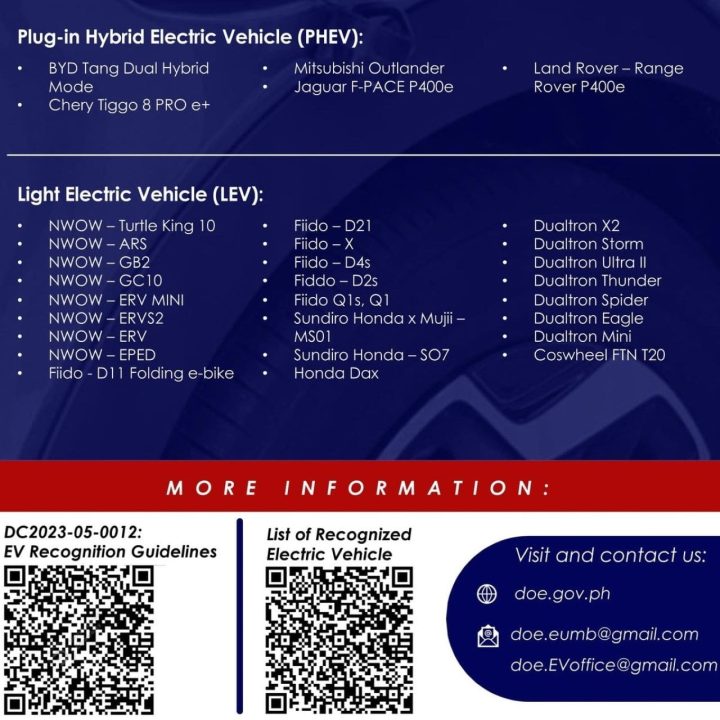
We all know that the Department of Energy is the one coming up with an officially Recognized EV List, right? You know, the list that includes all the “electric vehicles” that are exempted from the Unified Vehicular Volume Reduction Program (UVVRP) AKA Coding? Earlier this month they published such a list on their social media page, and guess what? Mild hybrids are not in it.
Mild Hybrids not part of the DOE’s most recent Recognized EV List

Photo: Department of Energy
The Recognized EV List(s) you will see below were posted on the Department of Energy Philippines’ Facebook page on August 4, 2023. The purpose of this list is to officially line up all the electric vehicles that will be exempted from Coding. We can remember that the MMDA recently asked for this list 221 to disseminate information to their enforcers so as not to pull over those who are rightfully exempted from the Coding scheme.
This exemption has been a very big draw for vehicle manufacturers in pushing their products, mild hybrids included. Many of these said manufacturers have confirmed – at least from their end – that some of their mild hybrid models will not be pulled over, but the latest list of the DOE begs to differ because there is not a single mild hybrid model from any brand that is included.

Photo: Department of Energy
Per the DOE’s definition, “Electric Vehicles (EVs) refer to vehicles with at least one (1) electric drive for vehicle propulsion”. Mild hybrids operate very differently in that it has a battery, but the battery itself does not power any motor to propel the vehicle. It merely acts as a secondary alternator that provides electrical power for the vehicle’s functions while the engine automatically turns on and off as it stops and goes.
The Implementing Rules and Regulations of the EVIDA state that a vehicle must have a system, powered electrically, that is capable of moving/mobilizing a vehicle. Mild hybrids, as we have described, do not have this ability or functionality.

Photo: Department of Energy
As it stands, the Recognized EV List is already quite extensive, but with this update, where does it leave those who have already bought mild hybrids and those who are considering them for the purpose of Coding exemption? We reckon that the list will still get a good deal of updates in the (near) future, but for now, those in this Recognized EV List will likely be the only ones honored by traffic and law enforcers as far as Coding rules go.
Of course, we’re hoping that mild hybrids 593 will be included in the future, too. Wishful thinking? We’ll all just have to wait and see.



With all due respect, once again, section 4.2 of the EVIDA Law does not discriminate. They defined it (in writing) that hybrid has 1 (regenerative) battery system and 1 fuel system. When the law makers were drafting this provision, the car industry had the 48V system as the most practical and affordable version of hybrid technology. Hence section 4.2
Arguing which is “true” and “false” hybrids is like arguing a “false” mestizo from a “true” mestizo. A mestizo is a mestizo. Perhaps one simply just can’t help it when some are twisting the obvious for their personal gain…
There’s no categorical way to say one is either 25% hybrid, or 50%, or even 100%, meaning “hybrid” is “hybrid”.
Nor to technically determine how “motion” is “assisted” by the electric system (such as in the case of the 48v EMS that can provide at an instant and added horsepower and torque while in sports mode). The fact that it is synergistic, it is functioning hybrid-ly!
Therefore even the word “propulsion” is in contention. Its primary definition is “the act of moving something forward”. While others may argue that it is pertaining to the initial force, it can also be argued that extending, so as to maximize, that forward momentum (independently – meaning with the combustion engine turned off) can also be loosely applied. The 48v EMS maximizes the technology during smart coasting speeds – maintaining the momentum (propulsion, aka forward motion) for an extended valuable time while the fuel-combustion engine is completely turned off. Now, how does this synergy then not harnessing the “Green” technology being promoted by DOE?
To insist on this argument is to be like a pharisee arguing the purpose of the Sabbath against the LORD of the Sabbath.
In short, that law have to be revised in order to make all these claims that discriminates against the 48vEMS hybrids. But I guess they are unable to do so so the IRR is their point of entry. Tweak the IRR to favor the one who is able to give bigger. Imagine how this would influence the competition? Imagine much this “endorsement” would translate to monthly sales.
Only on its fourth month of implementation, the Evida Law’s IRR is already a suspect, at least in reference to the very partial (pun intended) list of exempted being circulated, which is mostly Japanese cars, and mostly (T) and (L)brands. We wonder why…
Not sure how this feedback would even impact the playing fields. Perhaps this wouldn’t even make a dent. Nevertheless, I just hope this would somehow enlighten some of our good “lawyers” here to uphold the “correct” and “fair” interpretation of the law. Because in the end, if people will give up standing their grounds against these deliberate twisting of obvious truth, these errors would eventually be accepted by the majority as correct and true.